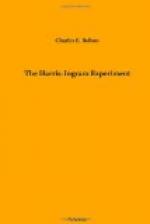Never before were streets so well paved, cleaned and sprinkled; never were city improvements so promptly made without increase of debt, and never did public schools prosper better. Men of experience on all lines were drafted on special committees and commissions, and vigorous work toward practical ends went forward on river, harbor, and other improvements.
Electricity, supplied by the city, furnished power, heat, and light. High pressure water relegated the steam fire-engine to the Historical Society, and low pressure water, at minimum cost, was supplied to the people in such abundance that during the summer season, before sunrise, all paved streets were cleansed by running water and brush brooms. All sewerage and garbage were promptly removed, and used to enrich the suburban market-gardens.
Every country road leading into the city had its electric railway with combination passenger and freight cars, and farm products for the people were delivered in better condition, earlier at the markets, and at much reduced prices. The advantages enjoyed by rich and poor in Harrisville were soon noised abroad, and the influx of new comers constantly increased the growth of the city. Mayor Ingram had been given a re-election. Prosperity in his own business had brought great returns, and the mayor’s chief concern was, what to do with his accumulations.
One day the County Commissioners, the City Government, the Chamber of Commerce, and the Board of Education were equally surprised to receive from George Ingram the announcement that he would build for the people at his own expense a court house, a city hall, a public library, and public baths. He had often wondered how it was possible that other millionaires could overlook and miss such opportunities to distribute surplus funds among the people. Gertrude early observed the city’s needs, and had pointed out the opportunity to George, urging that part of her father’s money should be united with their own increasing wealth to supply funds for the execution of their plans.
The four committees appointed by city and county acted speedily in the consideration of details. It was decided to construct a group of buildings on the park. The architecture adopted for all four structures was Romanesque in style; granite was used for wall work, and darker stone for ornamentation. The plans accepted exhibited less massiveness than the original Romanesque, and showed a tendency towards the lightness and delicacy of finish which modern culture demands.
The new court house located on the park enabled the architect to connect it by an historical “Bridge of Sighs” with the prison and old court house across the street. The city hall was properly made the most prominent of the group of buildings. Its first floor and basement were combined in a great assembly hall, capable of seating 10,000 people with an abundance of light, fresh air, and eight broad entrances for exit. As the belfry or tower was a leading feature of most mediaeval town-halls, so the artistic feature of the Harrisville city hall was its lofty tower, containing chimes, above which was to be placed an appropriate bronze statue. The library and the baths were built on the park.




